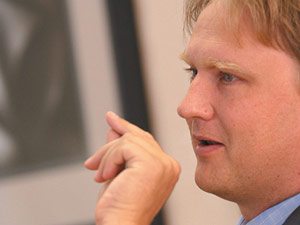
[miningmx.com] – SHARES in Pallinghurst Resources have been on the march this year, up 19%. This is certainly better than most mining counters, but still below the 23% gain in the JSE’s All Share Index.
Arne Frandsen, the firm’s CEO, acknowledges the share price has been stubbornly resistant to his investment team’s efforts, but he rails against the assertion that the group still has acres to prove.
The stock is 64% lower since Pallinghurst first listed, now some six years ago, but says Frandsen: “We’ve issued shares in that time, so mathematically, that statistic has no meaning.
“We’ve financed our growth with equity and now we have three businesses with strong balance sheets. In fact, if anything, we’ve been a bit boring since we’ve just gone about doing all the things we said we’d do.
“Yes, I ask myself about the share price, but it will come, and shareholders believe this too. They’ve supported us whenever we asked for funds’.
Pallinghurst’s three businesses are a 48% stake in Gemfields, a semi-precious business listed in London, and an 18% stake in Australia’s Jupiter Mines which owns the Tshipi Borwa manganese mine in South Africa’s Northern Cape province.
Then there’s Sedibelo Platinum Mines, formerly known as Platmin before it was decided to take it off the JSE whilst it set about consolidating its mining properties. The intention is that it become a 1.2 million oz/year platinum group metals producer, a forecast based on its Pilansberg Platinum Mine that Frandsen said is “making money’. It produced 64,000 ounces of platinum group metals in the half-year.
What’s interesting about the platinum investment is that Pallinghurst is taking it back to the JSE in 2014. This must be what the company means when it said in its interim results last week that it had “entered “. the harvesting stage of our investments’.
It certainly looks as if Pallinghurst may have its timing right.
The expectation is that supply of platinum from South Africa’s major mining firms will continue to shrink, while demand will gradually start to improve from 2014 into 2015. The R3.4bn pumped into Sedibelo by the Industrial Development Corporation also means the firm isn’t trying to raise cash when it lists.
“I’m not coming with cap in hand,’ says Frandsen who acknowledges, however, that the listing will need a decent free-float. This will require a “balancing act’ as Frandsen terms it.
Pallinghurst investors will want as much exposure to the listing as possible – certainly Frandsen rules out exiting the stock for at least a year or two – while a decent free-float will be required or the point of lising it lost.
According to Frandsen, Pallinghurst has a net asset value of R4/share representing nearly a 50% discount to the share price, and excluding any value that may be generated by the platinum listing. There are some other levers in the company that, if pulled, could see Pallinghurst help narrow the discount.
One is getting access to the Esperance port in western Australia where Jupiter Mines’ Mount Mason mine is situated. Frandsen estimates the mine could triple company cash flow. Then there’s getting Gemfields to pump.
At the moment, Gemfields is playing ping-pong with the Zambian government on where to hold auction of its stones. The Zambians want the auctions exclusively in Zambia much as Botswana has been able to twist De Beers’ arm in having diamond sights in Gaborone, with all the attendant spin-off benefits such as tourism and banking. A recent auction of rubies in Zambia generated $31.5m – more than achieved in any of Gemstone’s Singaporean auctions.
Frandsen says the company is working on a middle ground that could involve sharing auctions with Mozambique where Gemfields will soon start selling rubies.
“This is not a Zambian problem, it’s much broader than that. But we’ll keep the dialogue going. We’ve had positive meetings with the government and we’ll find the right decision,’ he says.









